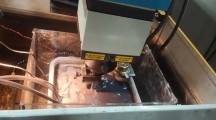Abstract
Powder-mixed electric discharge machining (PMEDM) of Ti6Al4V is performed in the current study using tungsten disulphide (WS2) powder as the additive in dielectric media. PMEDM at different levels of pulse on time (Ton) at three levels of powder concentrations was conducted, and it was observed that MRR improved with the PMEDM process. The surface roughness analysis of the PMEDM samples showed that there was not any direct relation with Ton time; however, with an increase in powder concentration, TWR was reduced. The PMEDM-prepared specimens were further used to analyse the tribological performance of surface-modified Ti6Al4V using pin-on-disc experimentation. PMEDM samples exhibited improved tribological performance in terms of coefficient of friction and specific wear rate (SWR). The lowest SWR was 2.8623E−05 at 2 gm/L, 40 µs Ton. During the dry condition sliding wear test, oxides of Ti (TiO) and Al (Al2O3) were formed due to the frictional heating, creating a protective tribofilm that helped to reduce wear. WS2 and its oxides were also identified during XRD analysis of the worn surface, which had lubricating properties bringing down the friction at the interface for the PMEDM samples. Abrasive and delamination wear were the predominant wear mechanisms identified on the worn surface.














Similar content being viewed by others
Abbreviations
- CoF:
-
Coefficient of friction
- EDM:
-
Electrical discharge machining
- EDX:
-
Energy-dispersive X-ray spectroscopy
- LVDT:
-
Linear variable displacement transducer
- MRR:
-
Material removal rate
- PMEDM:
-
Powder-mixed electrical discharge machining
- PMEDA:
-
Powder-mixed electrical discharge alloying
- PoD:
-
Pin-on-disc
- SEM:
-
Scanning electron microscopy
- SR:
-
Surface roughness
- SWR:
-
Specific wear rate
- Ti64:
-
Ti6Al4v
- TWR:
-
Tool wear rate
- XRD:
-
X-ray diffraction spectroscopy
- Al:
-
Aluminium
- Al2O3 :
-
Aluminium oxide
- EN31:
-
Case hardened steel
- Fe:
-
Iron
- gm/L:
-
Gram per litre
- gm/min:
-
Gram per minute
- Sa:
-
Average surface roughness
- Ti:
-
Titanium
- TiO:
-
Titanium oxide
- T on :
-
Pulse on time
- WO3 :
-
Tungsten trioxide
- WS2 :
-
Tungsten disulphide
References
Philip J T, Mathew J, and Kuriachen B, Friction 7 (2019) 497–536.
Geetha M, Singh A K, Asokamani R, and Gogia A K, Prog Mater Sci 54 (2009) 397.
Budinski K G, Wear 151 (1991) 203.
Niinomi M, J Mech Behav Biomed Mater 1 (2008) 30.
Kumar M, Datta S, and Kumar R, Arab J Sci Eng 44 (2019) 1553.
Qudeiri J E A, Zaiout A, Mourad A H I, Abidi M H, and Elkaseer A, Appl Sci 10 (2020) 1.
Philip J T, Kumar D, Mathew J, and Kuriachen B, Wear 458–459 (2020)
Ahmed N, Ishfaq K, Rafaqat M, Pervaiz S, Anwar S, and Salah B, Mater Manuf Process 34 (2019) 769.
Hasçalik A, and Çaydaş U, Appl Surf Sci 253 (2007) 9007.
Nair S, Dutta A, Narayanan R, and Giridharan A, Mater Manuf Process 34 (2019) 1824.
Rahul, Mishra D K, Datta S, and Masanta M, Silicon 10 (2018) 2263.
Kuriachen B, Mathew J, Mater Manuf Process 31 (2016) 439.
Joshi A Y, and Joshi A Y, Heliyon 5 (2019) e02963.
Tiwary A P, Pradhan B B, and Bhattacharyya B, Mater Manuf Process 34 (2019) 1103.
Gosai N, and Joshi A, Appl Mech Mater 813–814 (2015) 304.
Ekmekci N, and Ekmekci B, Mater Manuf Process 31 (2016) 1663.
Prakash C, Kansal H K, Pabla B S, and Puri S, Mater Manuf Process 32 (2017) 274.
Mughal M P, Farooq M U, Mumtaz J, Mia M, Shareef M, Javed M, Jamil M, and Pruncu C I, J Mech Behav Biomed Mater 113 (2021) 104145.
Öpöz T T, Yaşar H, Ekmekci N, and Ekmekci B, J Manuf Process 31 (2018) 744.
Thasleem P, Kuriachen B, Kumar D, Ahmed A, and Joy M L, J Tribol 143 (2021), 1.
Yadav A, Mohanty S, Dwivedi S, and Dixit A R, Surf Eng 38 (2022) 8.
Philip J T, Kumar D, Mathew J, and Kuriachen B, Trans Indian Inst Met 72 (2019) 2839.
Niu Q L, Zheng X H, Ming W W, and Chen M, Tribol Trans 56 (2013) 101.
Ju J, Zhao C, Kang M, Li J, He L, Wang C, Li J, Fu H, and Wang J, Tribol Int 159 (2021) 106996.
Yang Y, Zhang C, Wang Y, Dai Y, and Luo J, Tribol Int 95 (2016) 27.
Acknowledgements
The authors would like to thank the Department of Science and Technology (DST) sincerely, Govt. of India, for carrying out this project under the FIST (FIST – No. SR/FST/ETI-388/2015) scheme. Also, the authors thank the UGC DAE Consortium for Scientific Research for the partial financial support to complete this project under CRS/2021-22/04/636. The assistance extended by Mr. Renumala Sudheer, M.Tech Scholar, Department of Mechanical Engineering, National Institute of Technology Calicut, to complete the experimenters is also acknowledged.
Author information
Authors and Affiliations
Corresponding author
Additional information
Publisher's Note
Springer Nature remains neutral with regard to jurisdictional claims in published maps and institutional affiliations.
Rights and permissions
Springer Nature or its licensor (e.g. a society or other partner) holds exclusive rights to this article under a publishing agreement with the author(s) or other rightsholder(s); author self-archiving of the accepted manuscript version of this article is solely governed by the terms of such publishing agreement and applicable law.
About this article
Cite this article
Joshy, J., Venkata Krishna Reddy, M., Kuriachen, B. et al. Effect of Powder-Mixed Electric Discharge Alloying Using WS2 on the Tribological Performance of Ti6Al4V. Trans Indian Inst Met 76, 2413–2424 (2023). https://doi.org/10.1007/s12666-022-02817-w
Received:
Accepted:
Published:
Issue Date:
DOI: https://doi.org/10.1007/s12666-022-02817-w




